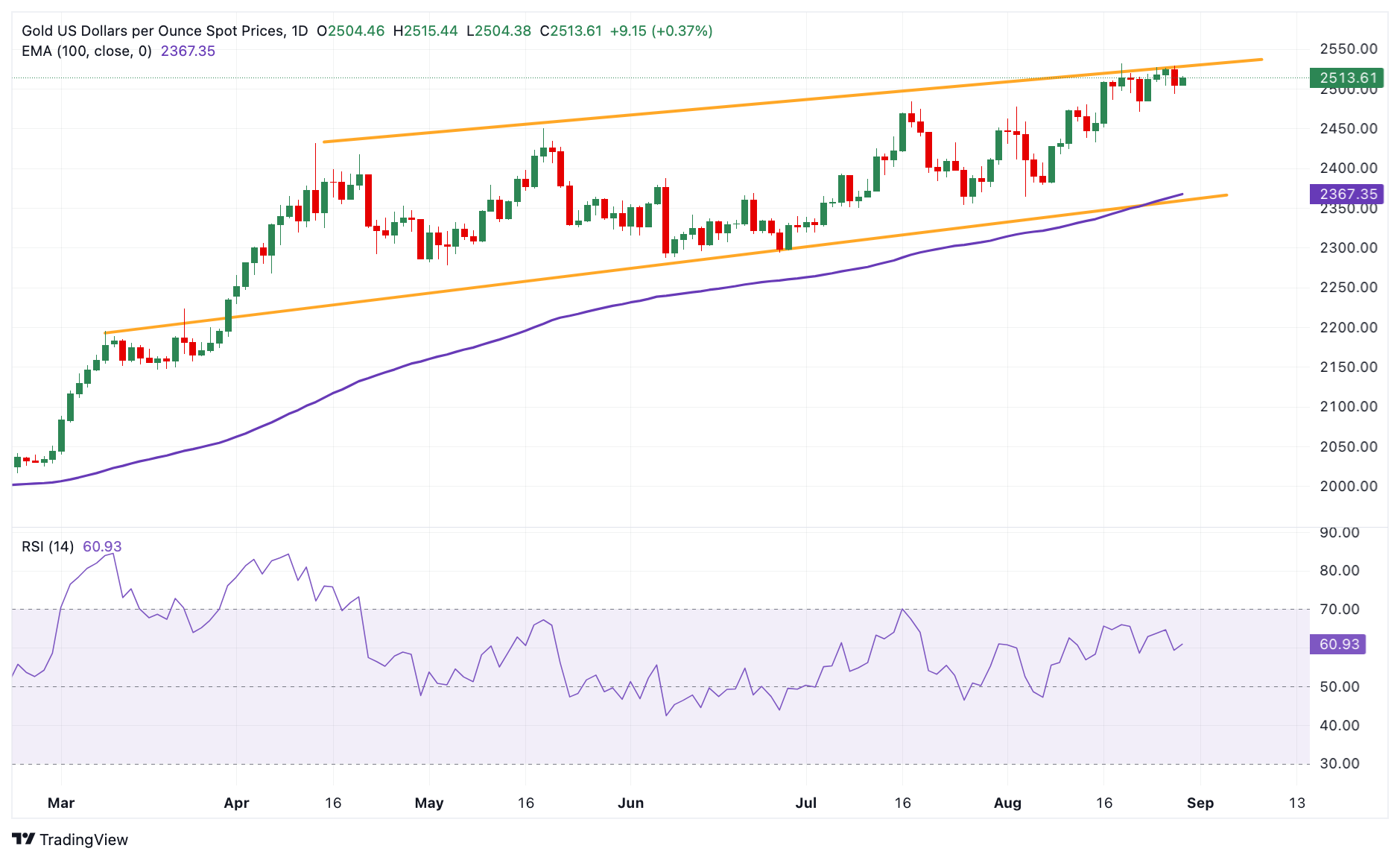Gold price gains ground as traders await US GDP data
- The Gold price rebounds above $2,500 in Thursday’s early Asian session.
- Rising Fed rate cut expectations and ongoing conflicts in the Middle East underpin the yellow metal.
- Firmer US Dollar might limit the Gold’s upside.
The Gold price (XAU/USD) recovers some lost ground on Thursday after bouncing off the weekly lows in the sub-$2,500 region per ounce troy. The expectation of US interest rate cuts might lift the Gold demand as lower interest rates reduce the opportunity cost of holding non-yielding gold. Additionally, the current political uncertainty in the US, geopolitical tensions in the Middle East and global economic concerns contribute to the precious metal’s upside.
On the other hand, the renewed US Dollar (USD) demand could weigh on the USD-denominated Gold price as it makes gold more expensive for most buyers. Investors will closely monitor the preliminary US Gross Domestic Product for the second quarter (Q2) on Thursday for more cues about the size and pace of the Federal Reserve (Fed) rate cut. On Friday, the US Personal Consumption Expenditures (PCE) Price Index data for July will take center stage.
Daily Digest Market Movers: Gold price remains strong amid rising rate cut bets
- Demand for gold will continue to be driven by emerging markets, particularly China, India, and Turkey, noted John Reade, Chief Market Strategist at the World Gold Council.
- “US data has failed to give gold any further lift, so the temptation for traders to book some profit after a long run has been rising,” said Ole Hansen, head of commodities strategy at Saxo Bank A/S.
- The US Gross Domestic Product (GDP) growth number for Q2 in the second estimate is expected to grow 2.8%.
- The headline Personal Consumption Expenditures (PCE) Price Index is expected to show an increase of 2.6% YoY in July, compared to 2.5% in June. The core PCE inflation is projected to rise from 2.6% to 2.7% YoY.
- The rate futures markets have fully priced in a 25 basis points (bps) rate cut in September, while the possibility of a deeper rate cut stands at 36.5%, according to the CME FedWatch Tool. Traders see 100 bps Fed easing this year.
Technical Analysis: Gold price offers a bullish outlook in the longer term
The Gold price trades in positive territory on the day. The precious metal remains stuck under a five-month-old ascending channel upper boundary and the all-time high. However, the overall picture is bullish, with the price well above the key 100-day Exponential Moving Average (EMA) on the daily timeframe. The upward momentum is confirmed by the 14-day Relative Strength Index (RSI) positions above the midline near 61.00, indicating that there is potential room for further upside.
The confluence of the all-time high and the upper boundary of the trend channel in the $2,530-$2,535 zone acts as the crucial upside barrier for the yellow metal. Extended gains could see a rally to the $2,600 psychological mark.
The immediate support level for XAU/USD is located at the $2,500 round figure. A decisive break below this level could lead to a significant sell-off towards $2,432, the low of August 15. The next contention level is seen at $2,367, the 100-day EMA.

Gold FAQs
Gold has played a key role in human’s history as it has been widely used as a store of value and medium of exchange. Currently, apart from its shine and usage for jewelry, the precious metal is widely seen as a safe-haven asset, meaning that it is considered a good investment during turbulent times. Gold is also widely seen as a hedge against inflation and against depreciating currencies as it doesn’t rely on any specific issuer or government.
Central banks are the biggest Gold holders. In their aim to support their currencies in turbulent times, central banks tend to diversify their reserves and buy Gold to improve the perceived strength of the economy and the currency. High Gold reserves can be a source of trust for a country’s solvency. Central banks added 1,136 tonnes of Gold worth around $70 billion to their reserves in 2022, according to data from the World Gold Council. This is the highest yearly purchase since records began. Central banks from emerging economies such as China, India and Turkey are quickly increasing their Gold reserves.
Gold has an inverse correlation with the US Dollar and US Treasuries, which are both major reserve and safe-haven assets. When the Dollar depreciates, Gold tends to rise, enabling investors and central banks to diversify their assets in turbulent times. Gold is also inversely correlated with risk assets. A rally in the stock market tends to weaken Gold price, while sell-offs in riskier markets tend to favor the precious metal.
The price can move due to a wide range of factors. Geopolitical instability or fears of a deep recession can quickly make Gold price escalate due to its safe-haven status. As a yield-less asset, Gold tends to rise with lower interest rates, while higher cost of money usually weighs down on the yellow metal. Still, most moves depend on how the US Dollar (USD) behaves as the asset is priced in dollars (XAU/USD). A strong Dollar tends to keep the price of Gold controlled, whereas a weaker Dollar is likely to push Gold prices up.

